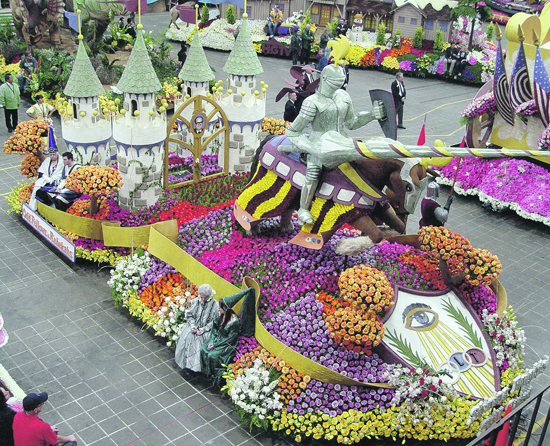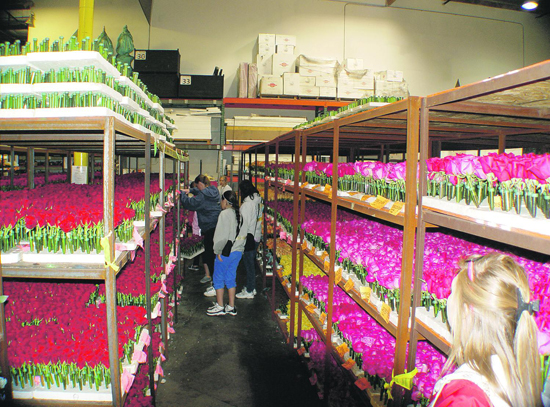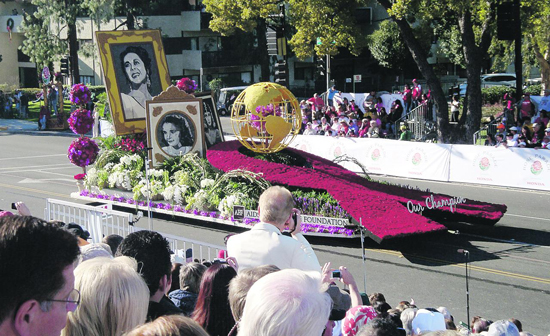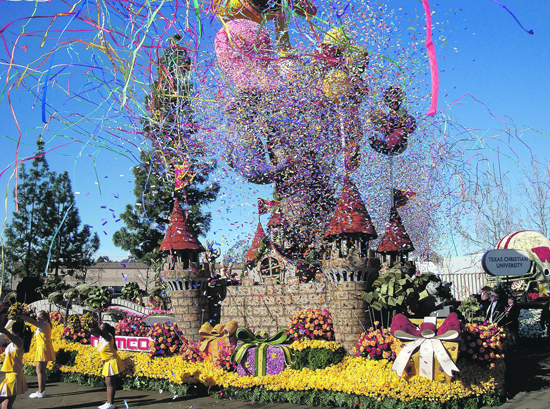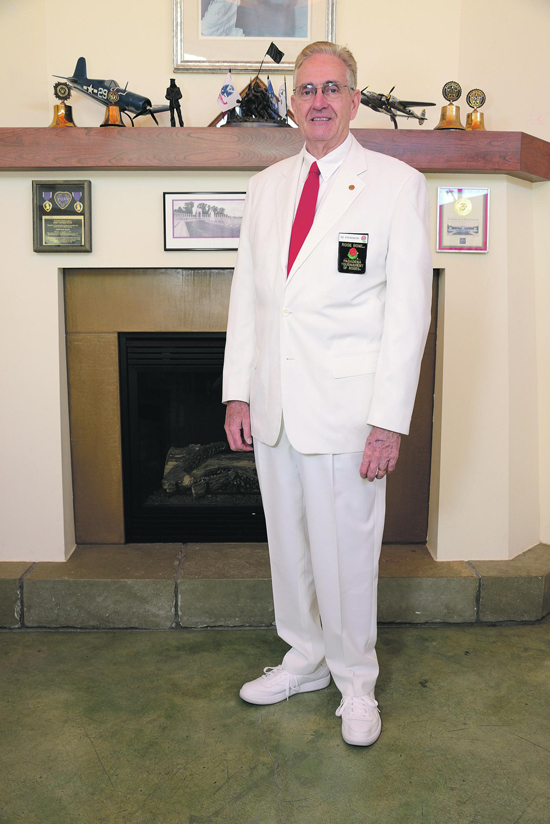 | | | Retired Maj. Ed Stevenson has likely been part of your family's New Year's
Day nearly every year for the past 30 years without you ever realizing it.
One of a select few Americans to have the honor of putting on the distinctive white suit worn by Tournament of Roses Association volunteers,
Stevenson has been among the earliest on scene and last to leave, helping
with everything from float decoration to judging, as well as troubleshooting to keep the Rose Parade running smoothly. Photo Ohlen Alexander
| | | | | |
Tiny tots wowed into silent wonder by the sheer awesomeness of ginormous, flower-bedazzled floats. Parents pumping fists proudly as their high schoolers strut with marching bands. Americans have been engaged in a shared obsession with the Tournament of Roses Parade since 1898 when East Coast newspapermen first traveled west to cover the phenomenal flower fiesta.
 Although Ed Stevenson wasn't on hand back then, he has witnessed many exciting times since joining the Tournament of Roses Association in 1984. Stevenson, who recently retired as general manager of the Lafayette Veterans' Building, gave Lamorindans a behind-the-scenes glimpse of life as "a White Suiter" during a December talk at Orinda's Masonic Lodge.
Although Ed Stevenson wasn't on hand back then, he has witnessed many exciting times since joining the Tournament of Roses Association in 1984. Stevenson, who recently retired as general manager of the Lafayette Veterans' Building, gave Lamorindans a behind-the-scenes glimpse of life as "a White Suiter" during a December talk at Orinda's Masonic Lodge.
 "I grew up in Sunnyvale and was in the high school band," said Stevenson, a California State University, Hayward graduate. Earning a Bronze Star Medal with the Marines in Vietnam, he retired as a major. In 1982, work took him to Southern California, where he began helping La Caéada with its Rose Parade float. "That's how I got hooked." "I grew up in Sunnyvale and was in the high school band," said Stevenson, a California State University, Hayward graduate. Earning a Bronze Star Medal with the Marines in Vietnam, he retired as a major. In 1982, work took him to Southern California, where he began helping La Caéada with its Rose Parade float. "That's how I got hooked."
 To join, said Stevenson, you must work or live within 15 miles of Pasadena City Hall. But once you're in, you're in - even if you relocate. Now an Honorary Life Member, he served on 11 different committees before finally earning a spot with the Judging Committee. It's a coveted spot because the majority of floats now range in cost from $100,000 to $500,000 each due to animation and exotic flowers used. Many are now built by professionals.
To join, said Stevenson, you must work or live within 15 miles of Pasadena City Hall. But once you're in, you're in - even if you relocate. Now an Honorary Life Member, he served on 11 different committees before finally earning a spot with the Judging Committee. It's a coveted spot because the majority of floats now range in cost from $100,000 to $500,000 each due to animation and exotic flowers used. Many are now built by professionals.
 Still others exude a different beauty. Stevenson still chokes up when recalling the work of Donate Life (www.donatelifefloat.org/). Each year, the group honors deceased organ, eye and tissue donors while educating viewers about the shortage of organs available for transplant.
Still others exude a different beauty. Stevenson still chokes up when recalling the work of Donate Life (www.donatelifefloat.org/). Each year, the group honors deceased organ, eye and tissue donors while educating viewers about the shortage of organs available for transplant.
 The History of the Tournament of Roses
The History of the Tournament of Roses
 The Rose Parade began, according to the Tournament of Roses Association, "as a promotional effort by Pasadena's distinguished Valley Hunt Club." In 1890, members lured "former East Coast neighbors to a mid-winter holiday, where they could watch ... chariot races, jousting, foot races, polo and tug-of-war under the warm California sun. The abundance of fresh flowers, even in the midst of winter, prompted the club to add another showcase" - a parade "where entrants would decorate their carriages with hundreds of blooms."
The Rose Parade began, according to the Tournament of Roses Association, "as a promotional effort by Pasadena's distinguished Valley Hunt Club." In 1890, members lured "former East Coast neighbors to a mid-winter holiday, where they could watch ... chariot races, jousting, foot races, polo and tug-of-war under the warm California sun. The abundance of fresh flowers, even in the midst of winter, prompted the club to add another showcase" - a parade "where entrants would decorate their carriages with hundreds of blooms."
 Motion pictures were made in 1900. Organizers were forced to raise wires above the parade route to accommodate taller, wider wonders by 1908. A year later, Isabella Coleman, the woman for whom one of the parade's most prestigious trophies is named, began making her mark as the goddess of float design. By 1951, Bay Area residents were watching the spectacle in glorious color on television, thanks to KPIX.
Motion pictures were made in 1900. Organizers were forced to raise wires above the parade route to accommodate taller, wider wonders by 1908. A year later, Isabella Coleman, the woman for whom one of the parade's most prestigious trophies is named, began making her mark as the goddess of float design. By 1951, Bay Area residents were watching the spectacle in glorious color on television, thanks to KPIX.
 "The process of selecting a queen and court is one of the classic things" done by association members, said Stevenson. Roughly 1,300 girls from high schools around Pasadena audition each year. Chosen via competition, "not a beauty contest," Stevenson said they are "incredibly sharp ladies."
"The process of selecting a queen and court is one of the classic things" done by association members, said Stevenson. Roughly 1,300 girls from high schools around Pasadena audition each year. Chosen via competition, "not a beauty contest," Stevenson said they are "incredibly sharp ladies."
 The association president, however, is the only one permitted to choose the theme and grand marshal.
The association president, however, is the only one permitted to choose the theme and grand marshal.
 After many years of male grand marshals, the first woman received that honor in 1933 - Hollywood star Mary Pickford, who would ride "in a coach covered with lavender and shell-pink sweat peas, China lilies and pink roses," according to the Associated Press.
After many years of male grand marshals, the first woman received that honor in 1933 - Hollywood star Mary Pickford, who would ride "in a coach covered with lavender and shell-pink sweat peas, China lilies and pink roses," according to the Associated Press.
 Bob Hope was grand marshal twice (1947, 1969). Former President Dwight D. Eisenhower took a turn in 1964, followed by golfer Arnold Palmer (1965), and Walt Disney (1966). But it is Shirley Temple who has appeared most often. Presiding over the parade's 50th and 100th anniversaries, Temple was also the youngest grand marshal ever appointed, and served a third time with astronaut Buzz Aldrin.
Bob Hope was grand marshal twice (1947, 1969). Former President Dwight D. Eisenhower took a turn in 1964, followed by golfer Arnold Palmer (1965), and Walt Disney (1966). But it is Shirley Temple who has appeared most often. Presiding over the parade's 50th and 100th anniversaries, Temple was also the youngest grand marshal ever appointed, and served a third time with astronaut Buzz Aldrin.
 Despite those Hollywood ties, though, the parade isn't all glam, said Stevenson. Since its 1983 launch, the association's foundation has granted more than $2 million to support leadership, arts and recreation activities.
Despite those Hollywood ties, though, the parade isn't all glam, said Stevenson. Since its 1983 launch, the association's foundation has granted more than $2 million to support leadership, arts and recreation activities.
 Annual themes have included: Patriotism (1918), Tales of the Seven Seas (1934), Victory, Unity and Peace (1946), Dreams of the Future (1952), It's a Small World (1966), Through the Eyes of a Child (1971), A World of Wonders (1987), Echoes of the Century (1999), and It's Magical (2006). This year, the theme is Dreams Come True.
Annual themes have included: Patriotism (1918), Tales of the Seven Seas (1934), Victory, Unity and Peace (1946), Dreams of the Future (1952), It's a Small World (1966), Through the Eyes of a Child (1971), A World of Wonders (1987), Echoes of the Century (1999), and It's Magical (2006). This year, the theme is Dreams Come True.
 Hopefully, with the help of a little 2014 flower power, they really will.
Hopefully, with the help of a little 2014 flower power, they really will.

|

